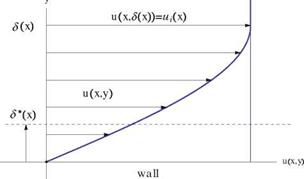Laminar Boundary Layer Theory (Prandtl 1904)
Let S be the boundary layer thickness which represents the limit beyond which viscous effects are negligible. Let l be the characteristic length of the obstacle. We assume that S ^ l, see Fig. 8.6. Inside the boundary layer one can simplify the Navier-Stokes equations, using order of magnitude analysis which is based on the rigorous technique of asymptotic expansion. The м-component of velocity is of order U, the incoming flow velocity. Pressure is assumed to be of order p = O (pU2), in other words, it can be written
|
Fig. 8.6 Geometric interpretation of displacement thickness S* (x) |
P(x, y) = pu2n(<8 27)
where П is a dimensionless function of x/1 and y/6(x) only. The coefficient in front of the dimensionless function, pU2, is called a “gage”. It gives the order of magnitude of the term. Furthermore, the partial derivatives are of order, respectively:
|
||
|
||
![]()
(a) From continuity, the two terms must balance, hence
|
|
The flow is almost aligned with the body.
(b) From the x-momentum equation: the acceleration terms in the left-hand-side are both of order O (pu^j and must balance the viscous term р,^ = о (pjU^j, hence
|
|

where the Reynolds number is defined as Rel = pU. In fact, this is true for any x sufficiently large, i. e.
where Rex = pUx. Note that if there is a pressure gradient in the x-direction, its order will match the other terms, as dp = о (p ufsj.
(c) Consider the y-momentum equation. First we multiply it by |: the acceleration terms in the left-hand-side are both now of order O (pир^ and balance the viscous
term of order O (p U^ as a consequence of the previous result (indeed, one term и has been replaced by v in both sides). The pressure derivative term is now of order O (pир. Comparing this term’s magnitude with the other terms indicates that this term dominates the equation since
|
U2 |
U262 |
U2 |
( 62 |
|
l > p 13 |
= pT |
U) * |
|
|
d p |
dv |
dv |
d2v |
|
dy y> pu dx |
+pv d |
0Г Pdy-2 |
As a result, to first order, the y-momentum equation reduces to one term and the pressure gradient in the y-direction must vanish
^ = 0 ^ p = p(x) = pi (x) (8.33)
d y
where the subscript i stands for “inviscid”, i. e. in the inviscid flow. Let ui (x) be the inviscid flow velocity at the edge of the boundary layer. From Bernoulli’s equation
p™ + [7] pU2 = pi (x) + 2p (u2(x) + v2(x)) ~ pi (x) + 2pu2(x) (8.34)
Taking the derivative in the x-direction yields
|
d2 u |
Hence the Prandtl boundary layer equations reduce to
This is a nonlinear system of two equations in two unknowns, (u, v) with a source term function of ui (x) provided by the inviscid flow. It is of parabolic type and can be marched in the flow direction as long as u(x, y) > 0.
The initial/boundary conditions are the following:
• at x = 0 u(0, y) = U, v(0, y) = 0, a uniform, undisturbed velocity profile is given,
• at y = 0, u(x, 0) = v(x, 0) = 0, along the solid wall,
• at y = S(x), u (x, S(x)) = ui (x), at the edge of the boundary layer.












